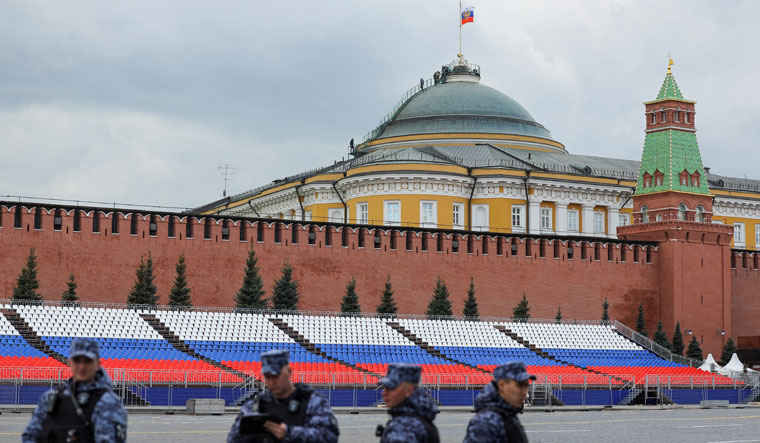In what may turn out to be one of the defining moments of the war in Ukraine till now, an enraged Russia has alleged that Kyiv had mounted a drone attack on the Kremlin Senate building targeting Vladimir Putin on Tuesday night.
A terse Kremlin press service statement said on Wednesday that Russia “reserves the right to take retaliatory measures where and when it sees fit.”
This has significantly escalated the ongoing war, opening up a slew of possibilities as to what Russia might do next.
Chief among them is the possibility of Russia unleashing its ‘Kinzhal’ (dagger in Russian) or Kh-47M2 hypersonic missiles to take out a high-value Ukrainian target. Known for its pinpoint accuracy, no known technology can stop a hypersonic missile as of now.
Inducted into the Russian military in March 2018, the ‘Kinzhal’ has been used on only two known occasions. The first use was on March 18, 2022, seemingly to send a warning message.
Russian defence ministry spokesman Igor Konashenkov had then said: “On March 18 (2022), the Kinzhal aviation missile system with hypersonic aeroballistic missiles destroyed a large underground warehouse of missiles and aviation ammunition of Ukrainian troops in the village of Delyatyn, Ivano-Frankivsk region.”
The Ivano-Frankivsk region is located in western Ukraine bordering Romania.
The second occasion was on March 9, 2023, when a barrage of six Kinzhals pounded into Ukraine in an alleged retaliatory strike to a ‘terror’ attack that killed two civilians in the southern Bryansk region. Russian authorities had alleged a group of ‘terrorists’ had fired on civilians in a car.
Meanwhile, Dmitry Medvedev, deputy secretary of Russia’s Security Council, said on Wednesday: “(After the attack) there are no options left but the physical elimination of Zelenskyy and his clique.”
The use of the highly maneuverable ‘Kinzhal’ that travels at Mach 10 or ten times the speed of sound, which translates to an astounding 3.5 km per second, may have been primarily meant as a warning to the arms and weapons consignments being sent in convoys and shipments by US-led NATO forces to aid Ukraine.
It was also a message that Russia would go to considerable lengths to impose its will in war-torn Ukraine and would not step back from its stated aims even if it meant an escalation of the war effort.
Mounted on a MiG-31 upgraded interceptor jet, the ‘Kinzhal’ can hit targets both on land and at sea and can strike at a range over 2,000 km without entering the enemy’s air defence zone.
On Wednesday, the Kremlin press service statement said there were two unmanned aerial vehicles (read drones) that were aimed at the Kremlin but were put out of action as a result of “timely actions taken by the military and special services using radar systems”.
The statement said that The Kremlin regarded these actions as “a planned terrorist act and an attempt on the life of the Russian President, carried out on the eve of Victory Day, the May 9 Parade.”
But there are questions too on the Kremlin attack. If at all fired by the Ukrainians, how could the drones penetrate the Russian air defence systems to attack a very secure and guarded target unless the drones originated from inside Russian territory? A video shows the drones exploding just over the Kremlin Senate building. And if already detected why were they allowed to fly so close to the Kremlin?
On Wednesday, Ukrainian presidential spokesman Sergey Nikiforov denied Ukraine’s role in the attack and that Kyiv had no information while claiming that the incident “is an escalation ahead of May 9 (Victory Day).”
Mikhail Podolyak, adviser to the head of the Ukrainian presidential office, has also been quoted by AFP as having said: “Ukraine has nothing to do with the drone attacks on the Kremlin.”
Interestingly, on Wednesday, the Russian deputy minister of defence Alexander Fomin at a briefing for the military attachés of friendly countries had remarked that Russia’s nuclear ‘activities’ are of a defensive nature aimed to guarantee protection of territorial integrity.



